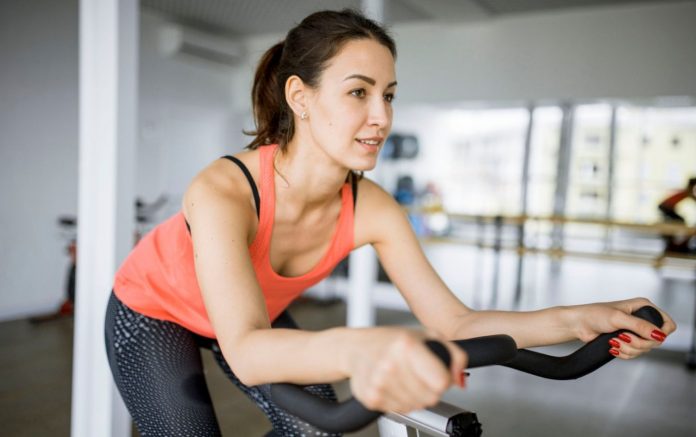I’ve been confused for a while now by the indoor cycling craze. People obviously love it, and I sort of get it—the music, the vibe, the intensity, the cardio! But there are some things about these classes that kind of get to me, as a fitness enthusiast and journalist. Namely: What is going on with those on-bike push-ups? I mean, seriously…why?
Bike push-ups—which you do by placing your hands on the handlebars, bending your elbows so your torso comes toward the bars, then straightening your arms out again (and repeating over and over again to the beat of the music) as you continue to pedal with your legs—are commonplace at many indoor cycling studios, including SoulCycle.
While I can appreciate the break in monotony and the distraction from the burn in my quads, I also just don’t really get it. What’s this move even doing? Is it really a push-up if I’m sitting down? How much upper-body strengthening am I even getting? And is there any possible downside?
Trying to do push-ups on the bike can mess with your cycling form.
“We tend to view the [on-bike] push-ups as a contraindicated movement,” Darci Kruse, C.S.C.S., director of education for the National Exercise Trainer Association (NETA) and NETA-certified cycling instructor, tells SELF. In other words, the exercise “should not be taught.” Oops.
One reason is that it can throw off your cycling form. Proper pedaling involves both pushing down and pulling up with your legs. “It’s a full cycle stroke so it should be nice and smooth,” explains Kruse. Adding upper-body movement, she says, could negatively affect this ideal rhythm by introducing a jerky, disjointed motion.
Also, the level of coordination required to perform the push-ups may end up distracting you from pedaling as powerfully, Mark-Anthony Sanchez, a Beaverton, Oregon–based kinesiologist, USA Cycling Level 3 Coach with Wenzel Coaching, tells SELF.
Basically, trying to do a strength move, like push-ups, while pedaling simultaneously will likely reduce the overall quality of each, Nate Dunn, M.S., exercise science, USA Cycling Level 1 Coach, and head coach/founder of Data Driven Athlete, tells SELF. “I would never combine those two,” he says.
Also, the repetitive up-and-down movement of the push-up can put some extra tension in the upper body, says Kruse, which is contrary to good indoor cycling technique. “We repeatedly say, Relax your shoulders, release tension in the upper body,” says Kruse, describing cues typically given in a class. That’s because many people—especially during the most challenging parts of an indoor cycling class—will tense their shoulders, lock their arms, and tightly grip the handlebars, she explains. This can put extra stress in your wrists and shoulders and put your spine in a less-than-ideal position (ideal meaning neutral, not arched or rounded). Tensing your upper body can further takes your focus and energy away from pedaling powerfully.
This isn’t necessarily a pressing safety issue, but if you have existing back problems or a more limited range of motion, attempting to do push-ups on the bike might be painful or uncomfortable, Dunn says. That’s even more likely if you’re on a bike that’s not fitted correctly to your body—if the seat is too low, for example, or if the handlebars are too far in front—says Sanchez. Doing push-ups in this scenario could trigger shoulder, back, and/or neck pain. (If you’re newish to indoor cycling, be sure to grab an instructor before the class starts so they can help you position the seat correctly.)
There’s also the risk that you could lose your balance. “You are seated on a very narrow bike that’s a little bit of an unstable surface,” explains Kruse. If you don’t have enough core stability to control your body as you perform the push-ups, there’s a risk that your hands might slip off the handlebars and you could fall forward or to the side, she says.
They may make class more interesting, but significant strength benefits are unlikely.
The biggest benefit of doing push-ups on the bike seems to be that it makes class more interesting. If you’re someone who gets bored cycling for 45 minutes straight (I definitely do), you might welcome some extra movement to take your focus off the intense work you’re doing with your legs (yes, please). Or maybe you want another way to move to the music. Either way, pressing your arms to do push-ups along to the beat might do it for you. (Sanchez also says that the push-ups could potentially improve coordination, as you’re teaching different body parts to work in tandem.)
“I understand people incorporate it because it’s trendy and it’s fun and it’s different,” says Kruse. But beyond the excitement factor? You won’t get much—if any—strengthening benefits. That’s because the majority of your body weight is supported by the bike, she explains, which means during the push-ups, (which are a heavily modified version of an OG push-up, BTW) you’re working against very little resistance. For the average exerciser, it would take more substantial weight to actually challenge and thus strengthen your muscles.
It’s most effective to separate indoor cycling workouts and upper-body strength work.
In addition to on-bike push-ups, many indoor cycling classes include an arms-focused portion in which participants pick up light dumbbells (think one to three pounds) and perform upper-body exercises (such as shoulder raises and triceps extensions) while still seated atop the bike. Some instructors tell class-goers to stop pedaling during this portion; others encourage them to keep pedaling—the directive varies by studio and by instructor.
Either way, Kruse doesn’t recommend this type of strength-training-slash-cycling combo either. As mentioned, the bike seat provides a very narrow base of support, which means you must have a certain level of core engagement while performing the upper-body weighted moves to stay stable and execute the movements safely.
Dunn, on the other hand, doesn’t see huge safety risks by performing these weighted on-bike moves, but he also doesn’t see much to gain. His take: “It would make more sense to focus on [cycling] class and strength training separately, perhaps by introducing basic strength movements after the [on-bike] portion,” he says. That would provide the opportunity to “focus on proper form while lifting weights rather than trying to balance awkwardly on a bike.”
To get a full-body workout that combines both, Dunn recommends doing a standard indoor cycling class without push-ups, and then hopping off the saddle and performing functional upper-body strengthening exercises, like dumbbell presses, bench presses, and push-ups, on solid ground.
Other options: bent-over rows, bent-over flys, and front raises. (This upper-body workout is a great place to start.) These moves target the mid-to-upper back and shoulders, areas that are typically tight in most people, especially cyclists, because of the forward-leaning posture the activity requires, says Kruse. Doing moves to strengthen them can help counteract some of the tension indoor cycling class can cause.
For the majority of folks, a bike should serve as cardio, says Sanchez. Strength training should remain a separate, off-the-bike activity, so that you can give each the undivided attention it deserves.Healthy Life Style Trends































